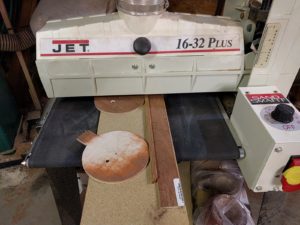I cut my own wood bindings. I like making everything for an instrument, and I get to make bindings of nice wood, nicer than I could buy, if indeed I could buy them. I don’t know of anyone who sells sycamore binding, much less sycamore binding cut exactly on the quarter, to maximize the sycamore figure. Bindings are also a great use for that extra side that is left over when re-sawing a block of nice wood.
The problem with cut bindings is that, even if I use a very fine toothed bandsaw blade, and set up the fence and saw carefully, the edges are a little rough, and things may not be exactly consistent width-wise along the binding strip. To fix this issue I made up a very simple jig.
It consists of a slab of particle board, a straight edge glued down to the board, and three circles (cut with the rosette cutter) each of which has a small handle. The straight edge and circles are cut out of think 3/16″ luan plywood. The circles are then screwed down with a countersunk flat head screw that is placed off-center. This off-center attachment means that as the circle is rotated, the edge gets closer or further away from the straight edge, meaning that one has a cam-type clamp that will clamp a bundle of binding strips stood on edge.
With the binding strips clamped in place, I then run the whole thing lightly through my thickness sander. This smooths and squares off the edges of the binding strips. I then flip the bundle over and repeat the process, which smooths and squares the other edges, and makes sure that the width of the strip is consistent both from strip-to-strip as well as along the length of the strips. I aim for 1/4″ wide bindings which is just above the 3/16″ jig. A simple jig but it works really well, producing very nice binding.

